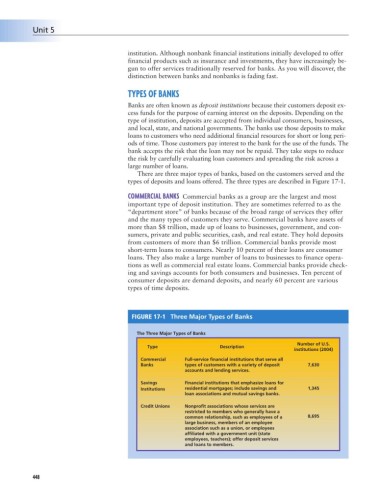Page 461 - Business Principles and Management
P. 461
Unit 5
institution. Although nonbank financial institutions initially developed to offer
financial products such as insurance and investments, they have increasingly be-
gun to offer services traditionally reserved for banks. As you will discover, the
distinction between banks and nonbanks is fading fast.
TYPES OF BANKS
Banks are often known as deposit institutions because their customers deposit ex-
cess funds for the purpose of earning interest on the deposits. Depending on the
type of institution, deposits are accepted from individual consumers, businesses,
and local, state, and national governments. The banks use those deposits to make
loans to customers who need additional financial resources for short or long peri-
ods of time. Those customers pay interest to the bank for the use of the funds. The
bank accepts the risk that the loan may not be repaid. They take steps to reduce
the risk by carefully evaluating loan customers and spreading the risk across a
large number of loans.
There are three major types of banks, based on the customers served and the
types of deposits and loans offered. The three types are described in Figure 17-1.
COMMERCIAL BANKS Commercial banks as a group are the largest and most
important type of deposit institution. They are sometimes referred to as the
“department store” of banks because of the broad range of services they offer
and the many types of customers they serve. Commercial banks have assets of
more than $8 trillion, made up of loans to businesses, government, and con-
sumers, private and public securities, cash, and real estate. They hold deposits
from customers of more than $6 trillion. Commercial banks provide most
short-term loans to consumers. Nearly 10 percent of their loans are consumer
loans. They also make a large number of loans to businesses to finance opera-
tions as well as commercial real estate loans. Commercial banks provide check-
ing and savings accounts for both consumers and businesses. Ten percent of
consumer deposits are demand deposits, and nearly 60 percent are various
types of time deposits.
FIGURE 17-1 Three Major Types of Banks
The Three Major Types of Banks
Number of U.S.
Type Description
institutions (2004)
Commercial Full-service financial institutions that serve all
Banks types of customers with a variety of deposit 7,630
accounts and lending services.
Savings Financial institutions that emphasize loans for
Institutions residential mortgages; include savings and 1,345
loan associations and mutual savings banks.
Credit Unions Nonprofit associations whose services are
restricted to members who generally have a
common relationship, such as employees of a 8,695
large business, members of an employee
association such as a union, or employees
affiliated with a government unit (state
employees, teachers); offer deposit services
and loans to members.
448

